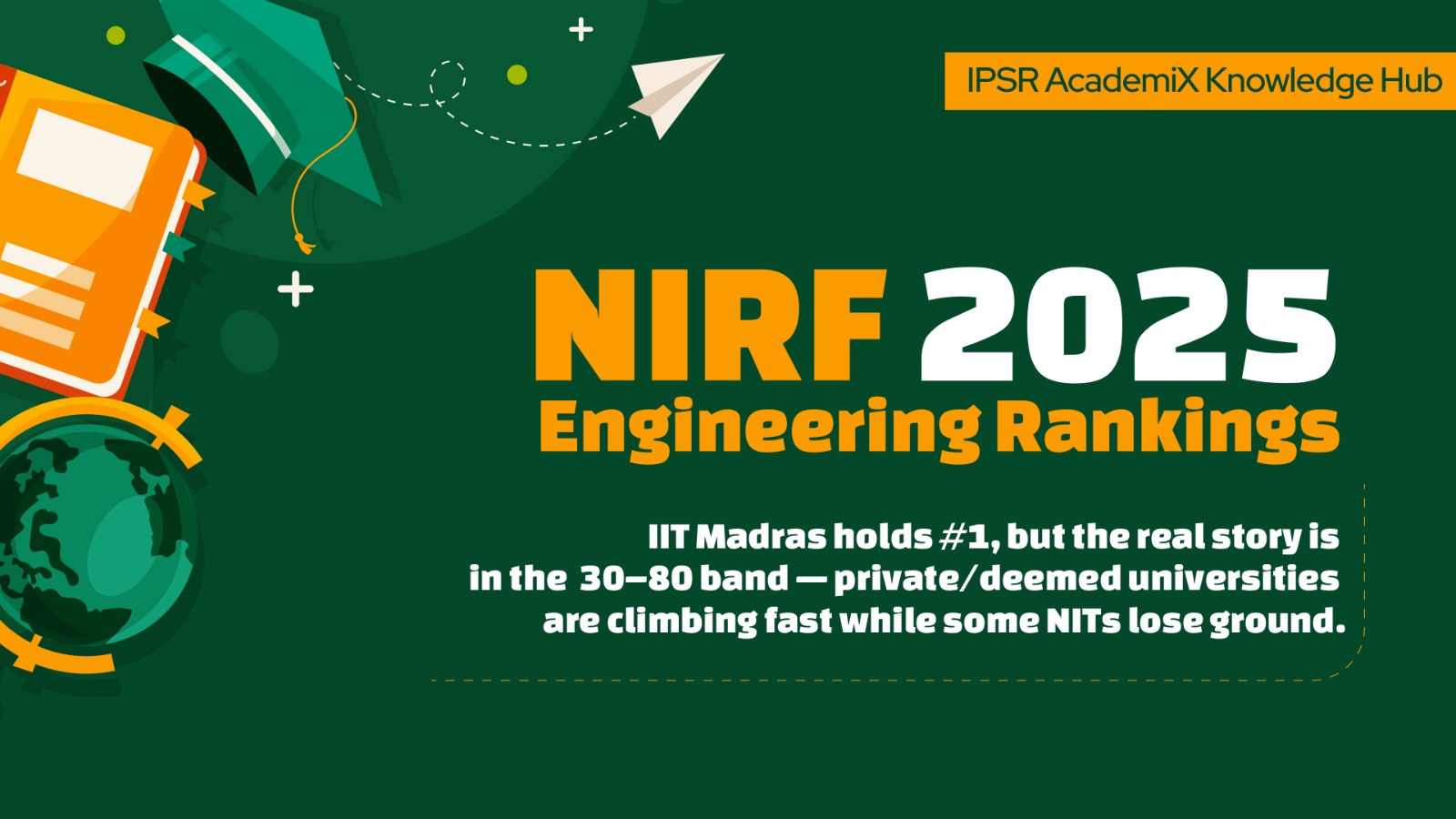
NIRF 2025 Engineering Rankings: Insights and Analysis of India’s Top 100 Engineering Institutions
Sep-10-2025,
Articles
Exploring patterns, trends, and the evolving landscape of technical education in India
The National Institutional Ranking Framework (NIRF) 2025, released on 4th September 2025, assessed 14,000+ institutions, with thousands competing in the Engineering category alone. While the headlines highlight IIT Madras retaining its #1 position, a closer look at the full Top 100 reveals patterns and undercurrents shaping India’s engineering education.
The Stability at the Top
The top positions reflect a set of institutions with unmatched academic excellence, consistent research output, and strong industry connections.
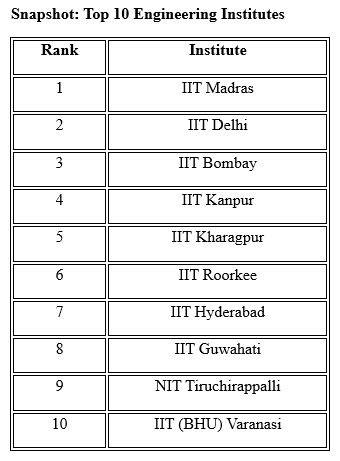
Highlights
- IIT Madras retains its #1 position for the 7th consecutive year, reaffirming its leadership across research, innovation, and teaching excellence.
- IIT Delhi continues its consistent run within the Top 3, maintaining strong performance metrics.
- IIT Bombay holds firm at #3, showcasing steady output and reputation.
- NIT Tiruchirappalli is the only NIT in the Top 10, representing the strength of India’s NIT ecosystem.
- IIT (BHU) Varanasi maintained its #10 ranking, a rare case of year-on-year stability in this highly competitive tier.
Analysis
The Top 10 positions remain remarkably stable, reflecting a core group of institutions with sustained excellence and robust systems for teaching, research, and industry collaboration.
- The first eight positions are exclusively IITs, reaffirming their dominance driven by:
- High research output and patents.
- World-class faculty and cutting-edge labs.
- Strong graduation outcomes, including placements and higher studies.
- Global partnerships and a powerful perception score, making them attractive to both students and recruiters.
- NIT Trichy’s presence at #9 illustrates the strength of India’s second-tier elite institutions and the resilience of the NIT network.
- IIT-BHU holding steady at #10 is particularly notable given the increasing competitiveness in the mid-tier. This consistency speaks to institutional governance and strategic focus.
Beyond the Top 10: Rising Competition
The real action happens in ranks 11–30, where non-IITs are steadily climbing.
- BITS Pilani’s rise to #11 (up 9 ranks) highlights its strong research ecosystem and global outlook.
- VIT (#16) and SRM (#14) continue to reinforce Tamil Nadu’s engineering depth.
- Institutions like IIIT Hyderabad, Thapar Institute (#29), and Chandigarh University (#31) are gradually narrowing the performance gap.
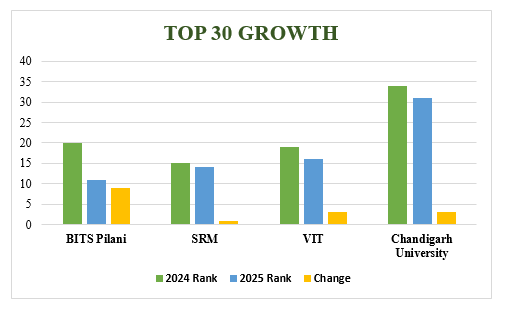
This tier reflects India’s shift toward a more diversified landscape, where private and deemed universities challenge traditional public institutions.
Mid-Tier Dynamics: 30–80 Band
The middle ranks have become highly competitive and fluid.
- Private universities such as Amity (#37), Symbiosis (#46), LPU (#48), and Chitkara (#89) are consolidating their positions through sustained investment in placements and research.
- Movement here is volatile, with institutions like Christ University (+17) and Vignan’s Foundation (+11) making significant leaps, while others like DIAT Pune (-29) experienced sharp declines.
Insight:
Even small gains in Research (RP), Teaching (TLR), or Perception can trigger double-digit changes in this compressed middle band.
Tamil Nadu: The Powerhouse of Engineering
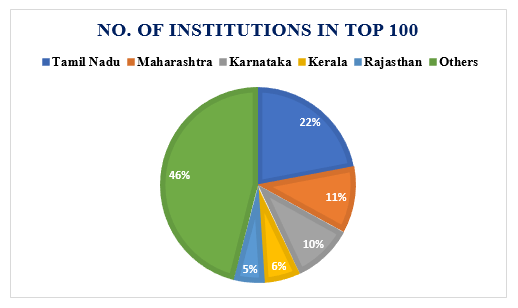
Tamil Nadu once again leads in terms of representation and diversity:
- IIT Madras (#1) and NIT Trichy (#9) anchor the top tier.
- Private institutions dominate the mid-tier, including VIT, SRM, Anna University, Amrita Vishwa Vidyapeetham, SASTRA, SSN, PSG, and Sri Krishna College.
This reflects decades of state-level focus on technical education, coupled with strong industry-academia linkages.
Kerala’s Balanced Mix
Kerala maintains a healthy balance of institutions across ranks:
- NIT Calicut (#21) leads the state’s representation.
- CUSAT (#55) and IIST Thiruvananthapuram (#61) maintain mid-table visibility.
- IIT Palakkad (#64) continues its gradual rise as a new-generation IIT.
This mix of central, state, and emerging institutions showcases Kerala’s steady progress in technical education.
Regional Spread: Quality Engineering Expands Nationwide
The rankings highlight the growing geographic diversity of quality engineering education:
- Rajasthan: MNIT Jaipur (#42)
- Uttarakhand: UPES Dehradun (#43)
- Northeast: NIT Meghalaya (#83)
- Jammu & Kashmir: NIT Srinagar (#73)
- Chhattisgarh: IIT Bhilai (#72)
Observation:
This spread ensures students across India have access to quality education, reducing regional imbalances.
Risers vs. Fallers: Signals of Change
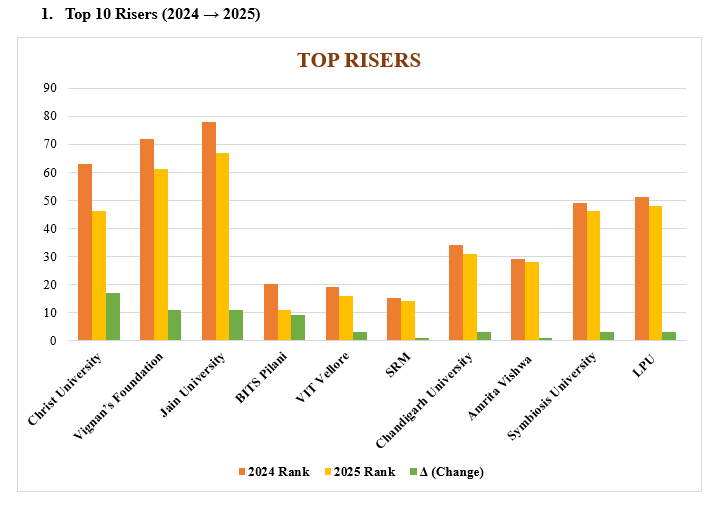
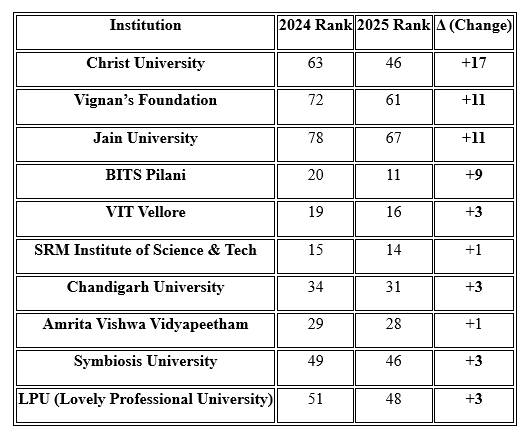
Observation:
- Christ University saw the largest jump (+17), indicating strong improvements in Research, Perception, and Outreach.
- BITS Pilani re-entered the Top 15, reflecting a stronger research footprint and global collaborations.
- Private universities dominate the top risers, showing intense competition in the mid-tier segment.

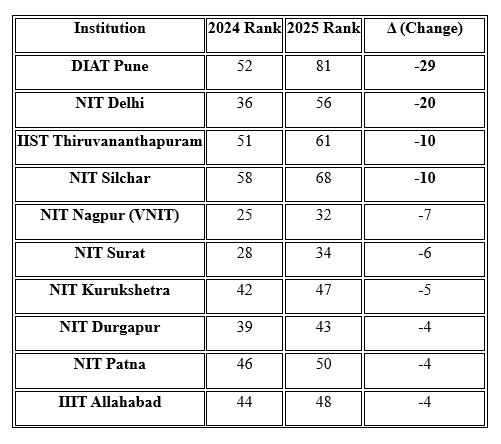
Observation:
- DIAT Pune’s sharp drop (-29) may indicate challenges in research output and perception scores.
- NIT Delhi (-20) and NIT Silchar (-10) reflect internal operational or resource issues.
- The decline of multiple NITs suggests rising pressure from private universities.
Understanding the Sub-Scores
The overall rank is a composite of five weighted metrics:

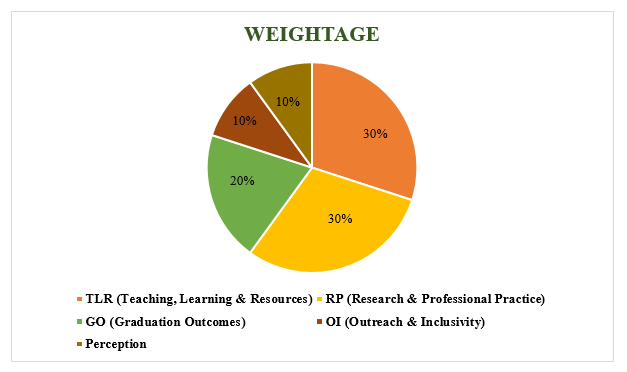
Key Insight:
For mid-tier institutions, focusing on RP and Perception offers the highest leverage for rapid improvement.
Bottom Edge Volatility: #95–#100
The final stretch of the Top 100 sees frequent churn, with new or returning entrants such as:
- C.V. Raman Global University, Odisha (#95)
- Atal Bihari Vajpayee IIIT&M (#96)
- Sri Krishna College of Engineering & Technology (#100)
Maintaining presence in this range is challenging, emphasizing the need for continuous improvement and consistency.
What This Means for Stakeholders
For Institutions
- Rankings offer a benchmark to identify strengths and gaps.
- Key focus areas: research ecosystems, faculty development, industry linkages, and inclusive policies.
For Students and Parents
- Rankings help guide informed choices, especially in differentiating mid-tier institutions with similar reputations.
For Policymakers
- Regional insights support targeted interventions to strengthen weaker ecosystems.
Conclusion: The Shifting Shape of Engineering Education
The NIRF 2025 Engineering rankings illustrate a dynamic ecosystem:
- Stability at the top with IITs and NIT Trichy leading.
- A competitive mid-tier, where small improvements yield big ranking changes.
- Private sector growth, making technical education more diverse and accessible.
- Expanding regional representation, ensuring equitable access across India.
While rankings are not the only measure of quality, they drive transparency and accountability, pushing institutions to innovate, improve, and ultimately deliver better outcomes for students and society.
India’s engineering future isn’t defined by the top 10 alone, it’s shaped by the collective progress of the full 100 and beyond.
Dr. Mendus Jacob, is the CEO of ipsr solutions limited and Professor & Director of the MCA Programme at Marian College, Kuttikkanam (Autonomous), with over 35 years of experience as an academician and entrepreneur. He is the former Director of School of Applicable Mathematics, M. G. University, Kerala. A Ph.D. in Operations Research with numerous publications, he has served on academic bodies of universities and autonomous institutions, produced Ph.D.s, and been a sought-after resource person for global conferences and faculty development programmes. An expert in NEP, Outcome Based Education, and Accreditation, he has mentored prestigious universities and trained over 40,000 faculty members nationwide on OBE implementation.












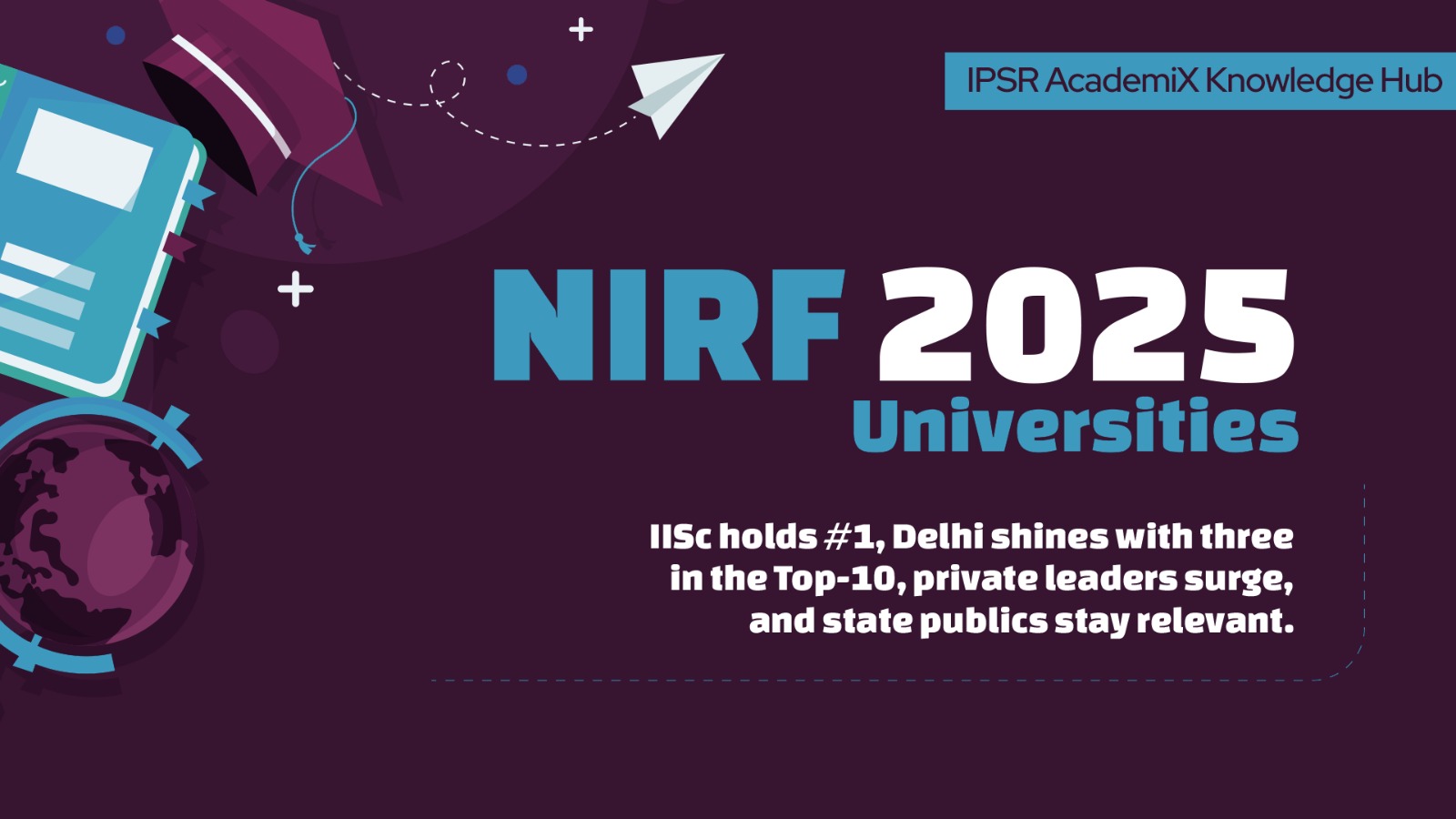


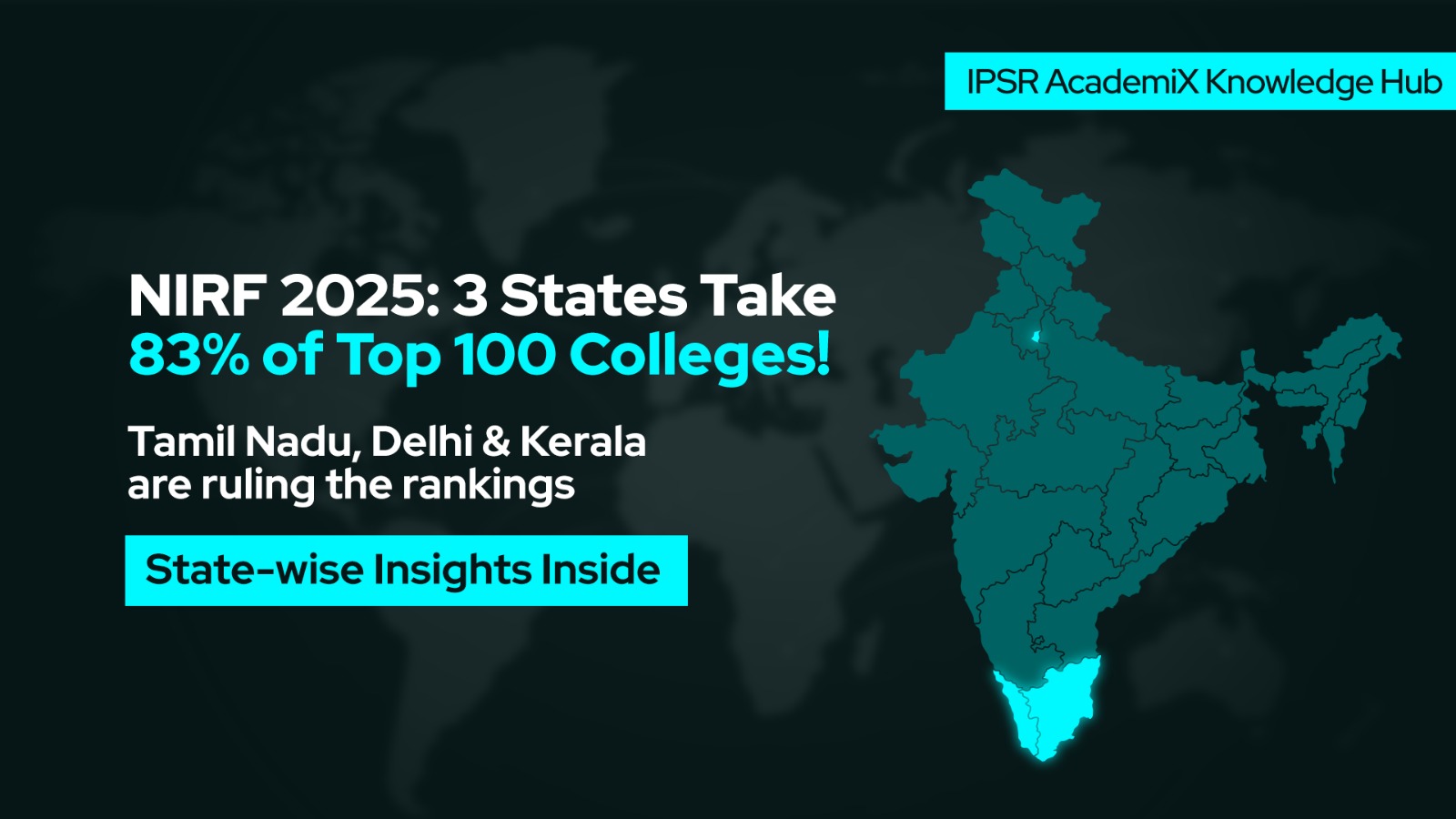



Leave A Comment